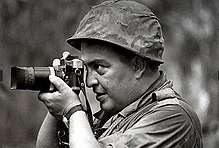Horst Faas
Horst Faas (28 April 1933 – 10 May 2012) was a German photo-journalist and two-time Pulitzer Prize winner. He is best known for his images of the Vietnam War.[1]
Horst Faas | |
|---|---|
 | |
| Known for | photojournalism |
| Awards |
|
Life
Born in Berlin, Germany, Faas began his photographic career in 1951 with the Keystone Agency, and by the age of 21 he was already covering major events concerning Indochina, including the peace negotiations in Geneva in 1954. In 1956 he joined the Associated Press (AP), where he acquired a reputation for being an unflinching hard-news war photographer, covering the wars in Vietnam and Laos, as well as in the Congo and Algeria. In 1962, he became AP's chief photographer for Southeast Asia, and was based in Saigon until 1974. His images of the Vietnam War won him a Pulitzer Prize in 1965. In 1967 he was severely wounded in the legs by a rocket-propelled grenade. In 1972, he collected a second Pulitzer, for his coverage of the conflict in Bangladesh. Inside Bangladesh, photographer Rashid Talukder considered it too dangerous to publish his photographs and he released them more than twenty years after Horst's photographs had appeared.[2]
Faas is also famed for his work as a picture editor, and was instrumental in ensuring the publication of two of the most famous images of the Vietnam War.[3] On June 18, 1965, during the Vietnam War with the 173rd Airborne Brigade Battalion on defense duty at Phouc Vinh airstrip in South Vietnam he took the iconic photo of a soldier wearing a hand lettered "War Is Hell" slogan on his helmet The notorious "Saigon Execution" photograph, showing the summary execution of a Viet Cong prisoner by Saigon police chief Nguyễn Ngọc Loan, taken by Eddie Adams in Saigon on February 1, 1968, was sent under his direction. Nick Ut's famous "Napalm Girl" photograph caused a huge controversy over at the AP bureau; an editor had objected to the photo, saying that the girl depicted was naked and that nobody would accept it. Faas ordered that Ut's photo be sent over the wire.
In September 1990, freelance photographer Greg Marinovich submitted a series of graphic photos of a crowd executing a man to the AP bureau in Johannesburg. Once again, AP editors were uncertain if the photos should be sent over the wire. One editor sent the images to Faas, who telegrammed back, "send all photos."[4]
In 1976, Faas moved to London as AP's senior photo editor for Europe; he retired in 2004. In retirement he organised reunions of the wartime Saigon press corps and ran international photojournalism symposiums.
He produced four books on his career and other news photographers, including Requiem, a book about photographers killed on both sides of the Vietnam War, co-edited with fellow Vietnam War photojournalist Tim Page.[5]
Awards
- 1965: Pulitzer Prize (Photography): "For his combat photography of the war in South Viet Nam during 1964."[6]
- 1964: Robert Capa Gold Medal for his "Coverage of Vietnam"
- 1972: Pulitzer-Prize (Spot News Photography) together with Michel Laurent: "For their picture series, 'Death in Dacca.'"[6]
- 1997: Robert Capa Gold Medal together with Tim Page: "Requiem: By the Photographers Who Died in Vietnam and Indochina"
- 2005: Dr. Erich Salomon Prize of the German Society of Photography for his lifetime achievement
References
- "Horst Faas, AP photographer who brought world compelling images of Vietnam, dies at age 79". The Washington Post. Associated Press. 2012-04-17. Archived from the original on 2012-05-12. Retrieved 2012-05-11.
- "Images of Independence, Finally Free". New York Times, Lens. December 5, 2012.
- "The man who shot Vietnam". NYTimes. December 8, 2017. Retrieved December 9, 2017.
- Marinovich, Greg; Silva, João (2000). The Bang-Bang Club: snapshots from a hidden war. Basic Books. ISBN 978-0-465-04413-9.
- "Horst Faas: Horst Faas, who has died aged 79, was an award-winning photographer best known for his arresting images of the Vietnam War". The Daily Telegraph. May 11, 2012.
- http://www.pulitzer.org/awards/1965
Further reading
Pyle, Richard and Faas, Lost over Laos: A True Story of Tragedy, Mystery, and Friendship (Da Capo Press: 2004) ISBN 0-306-81196-0. – David Halberstam introduces the book.